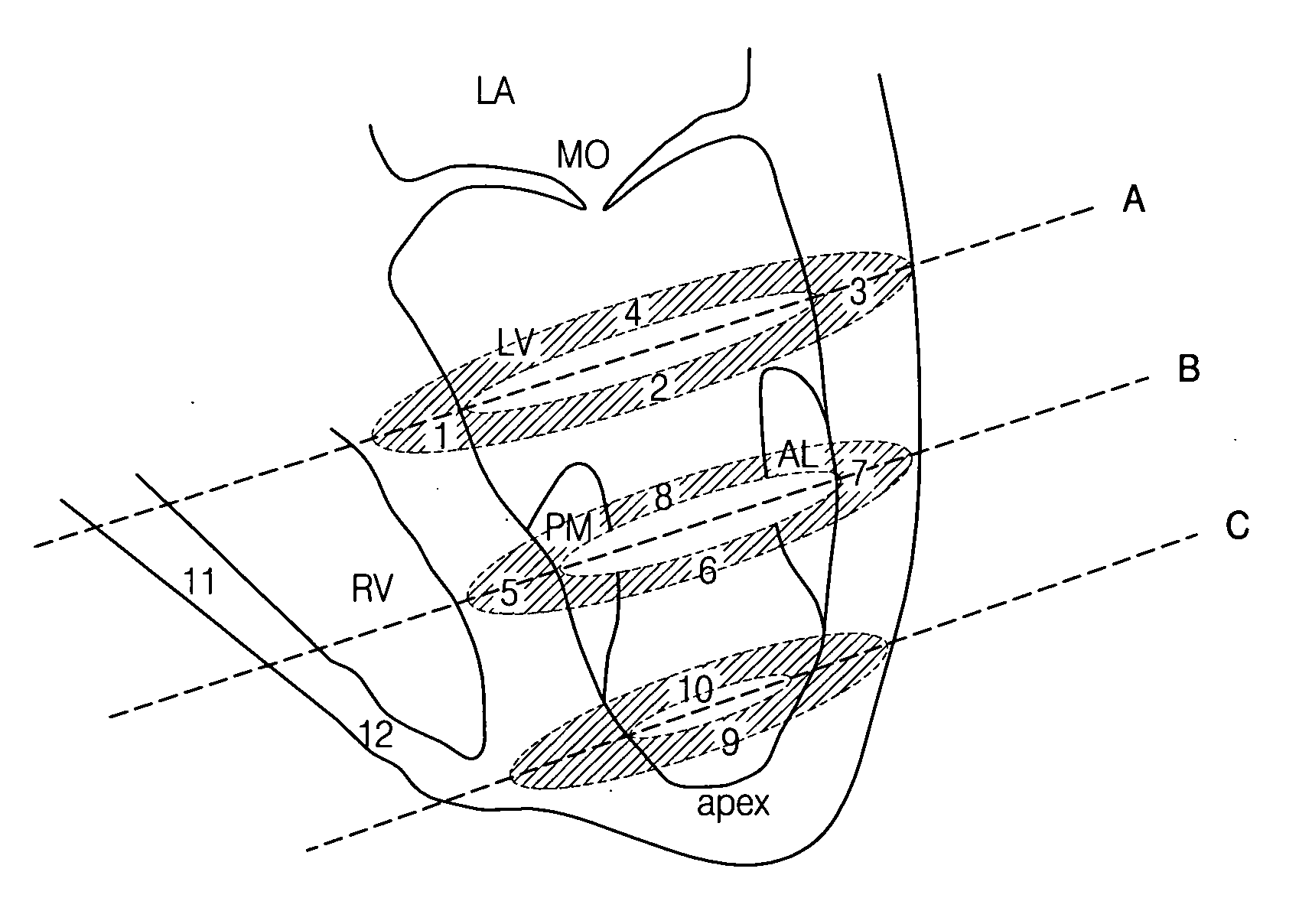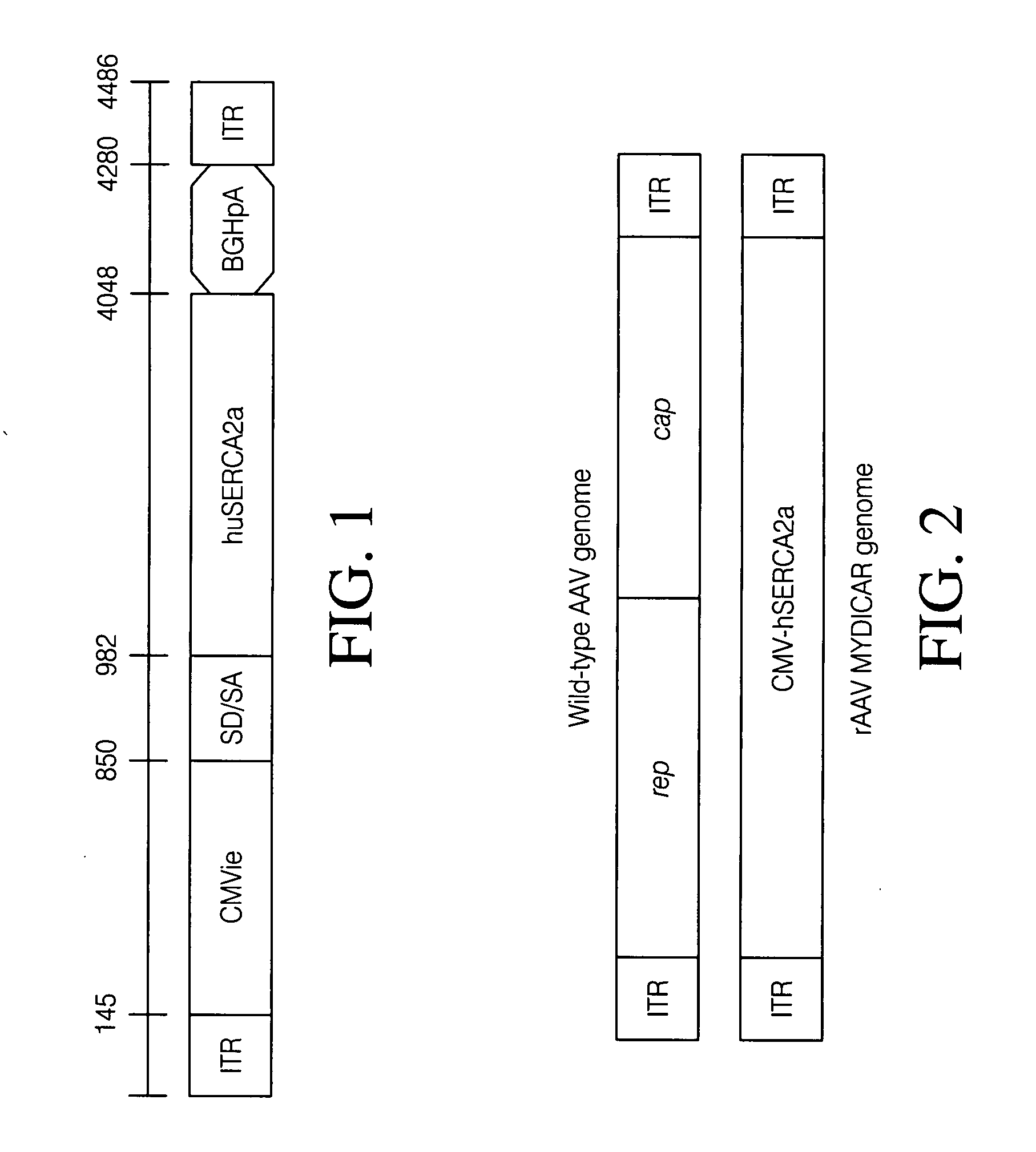Extended antegrade epicardial coronary infusion of adeno-associated viral vectors for gene therapy
a technology of adeno-associated viral vectors and epicardial infusion, which is applied in the direction of cardiovascular disorders, drug compositions, immunological disorders, etc., can solve the problems of insufficient clinical use of methods, and achieve the effects of enhancing cardiac contractility, enhancing lateral ventricle fractional shortening, and high diastolic calcium levels
- Summary
- Abstract
- Description
- Claims
- Application Information
AI Technical Summary
Problems solved by technology
Method used
Image
Examples
example 1
Effect of Infusion Time on Short Term Biodistribution of AAV2 / 1 / SERCA2a in Normal Minipigs
[0129] A study was conducted to evaluate transduction of heart muscle by quantification of vector-specific DNA after antegrade epicardial coronary infusion of AAV2 / 1 / SERCA2a in normal minipigs.
Groups
[0130] The control group (one animal) for this study was a no treatment control. This animal underwent all the same procedures as the other groups except for administration of AAV2 / 1 / SERCA2a. Experimental animals were administered 1×1012 DRP AAV2 / 1 / SERCA2a via coronary artery infusion catheter using a programmable syringe pump into the left coronary artery (5 animals in Groups 3-5) or direct intramuscular (IM) injection (a single animal in Group 2). Groups received AAV2 / 1 / SERCA2a at two vector concentrations and varying infusion rates. All groups receiving vector received a blood only flush of the dead volume of the tubing and catheter following vector administration. The animals were Gottingen ...
example 2
Effect of Vector Dose and Administration Route on Short Term Biodistribution of AAV2 / 1 / SERCA2a in Sheep
[0148] A pilot study was conducted to evaluate the short term biodistribution of three different doses of AAV2 / 1 / SERCA2a at 2 days following a single administration via infusion into the left coronary artery compared to an intravenous injection in normal sheep.
Groups
[0149] One animal received 1×1013 DRP of AAV2 / 1 / SERCA2a by an intracoronary artery catheter infused into the left coronary artery using a programmable syringe pump. A second group of three animals received 3×1012 DRP of AAV2 / 1 / SERCA2a, and a third group of two animals received 1×1012 DRP of AAV2 / 1 / SERCA2a, all by an intracoronary artery catheter infused into the left coronary artery using a programmable syringe pump. All infusion groups received the AAV2 / 1 / SERCA2a over 8 minutes at a constant flow rate of 2.5 mL / min., followed by a 2 minute blood-only flush of the catheter volume. A single animal in a control group ...
example 3
Swine Mitral Valve Regurgitation Model of Heart Failure
[0164] A pilot study was conducted to evaluate the effect of a single administration of AAV2 / 1 / SERCA2a on cardiac function as compared to a vehicle control in a porcine model of heart failure created by severe mitral valve regurgitation (MR). Mitral regurgitation (MR), also known as mitral insufficiency, is the abnormal leaking of blood through the mitral valve, from the left ventricle into the left atrium of the heart. Regurgitant volume, a measure of the severity of the MR, is the volume of blood that regurgitates into the left atrium
Groups
[0165] Yorkshire-Landrace swine, 3 months old, and between 30-40 kg were used in the study. The experimental group of four animals received 1×1012 DRP of AAV2 / 1 / SERCA2a by an intracoronary artery catheter infused into the left coronary artery using a Harvard Clinical Technology (HCT) infusion pump. The AAV2 / 1 / SERCA2a was delivered over a period of 8 minutes at a constant flow rate of 2.5...
PUM
| Property | Measurement | Unit |
|---|---|---|
| flow rate | aaaaa | aaaaa |
| flow rate | aaaaa | aaaaa |
| flow rate | aaaaa | aaaaa |
Abstract
Description
Claims
Application Information
 Login to View More
Login to View More - R&D
- Intellectual Property
- Life Sciences
- Materials
- Tech Scout
- Unparalleled Data Quality
- Higher Quality Content
- 60% Fewer Hallucinations
Browse by: Latest US Patents, China's latest patents, Technical Efficacy Thesaurus, Application Domain, Technology Topic, Popular Technical Reports.
© 2025 PatSnap. All rights reserved.Legal|Privacy policy|Modern Slavery Act Transparency Statement|Sitemap|About US| Contact US: help@patsnap.com



